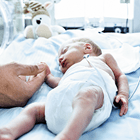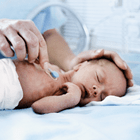Printed from acutecaretesting.org
April 2005
Transcutaneous monitoring in continuous use
|
The University College London Hospitals (UCLH) NHS Foundation Trust is one of the largest NHS trusts in the country. The Elizabeth Garrett Anderson and Obstetric Hospital houses the Trust's gynecology, obstetric and neonatal services. Level: Tertiary unit with a separate Special Care Unit |
acutecaretesting.org: When does a neonatal patient qualify for tc monitoring?
Margaret Gannon: Any newborn admitted with respiratory distress to the neonatal intensive care unit (NICU) at UCLH immediately qualifies for transcutaneous monitoring. If the baby shows signs of sternal recession, tachypnea, nasal flaring or using accessory muscles of respiration, she will be monitored with a transcutaneous probe.
acutecaretesting.org: What are the typical respiratory problems you encounter?
Margaret Gannon: UCLH admits some of the sicker, lower-gestation preterm babies in the London area. These are often surfactant-depleted babies who need respiratory support. Treating these babies for their respiratory problems is especially challenging during surfactant treatment, during invasive ventilation and weaning from ventilation.
acutecaretesting.org: How do you monitor the condition of the babies during treatment?
Margaret Gannon: We find tc a very effective form of monitoring for babies receiving surfactant and HFOV. These are two therapies that work very quickly, so it is important to know minute by minute what is happening, so ventilator settings can be adjusted accordingly.
The babies who have been extubated to CPAP are being monitored specifically for trends in tcpCO2. Tc monitoring is used in conjunction with blood gas analysis and continuous saturation monitoring.
acutecaretesting.org: What can cause these sudden changes in the CO2 status?
Margaret Gannon: Changes can be caused by fluctuations in lung compliance. Usually you will see clinical signs of infants getting tired and they will be using accessory muscles of respiration to breathe. Pneumothorax can also cause a sudden increase in tcpCO2.
acutecaretesting.org: How does tc monitoring assist you in your daily work?
Margaret Gannon: The tc monitoring is good because it gives us both O2 and CO2 trends. You get to know the normal levels of the individual babies and will be able to determine when an increase in tcpCO2 is a cause for concern.
Babies who have been ventilated for a longer period of time or who have chronic lung disease, may have a higher-than-normal tcpCO2, for example 11-12 kPa (83-90 mmHg).
acutecaretesting.org: Describe how the tc monitor is typically used in the neonatal unit?
Mae Nugent: The nurses use the tc values as part of the continuous patient monitoring. Every four hours, the nurse takes the tc probe off the baby and ensures that the membrane still lies flat over the electrode. While the probe is being calibrated, the nurse will check the skin site.
She will use a different measuring site to protect the skin. The time of calibration is documented in the infant's charts. When the tc probe is calibrated, the nurse will apply two drops of contact liquid in the adhesive ring, fix the probe and await stable readings. This usually takes 5-10 minutes.
acutecaretesting.org: What is a good measuring site?
Mae Nugent: The best measuring site is on soft tissue – not ribs, clavicles or shoulder blades – most often on the abdomen, the back (when prone) and sometimes the thighs. We avoid siting the probe near the liver or the heart, since we often have to use those areas for scanning.
acutecaretesting.org: How do you proceed if the readings are not stable?
Margaret Gannon: We would make sure that the reading was accurate before we took action on it. We would take off the probe, recalibrate it and replace it on the baby. If the values are still high, we will do a blood gas test to check correlation with tc values and assess the infant’s overall condition.
acutecaretesting.org: How do you combine tc values with arterial blood gas values?
Margaret Gannon: We correlate the results, and don’t use the tc completely instead of blood gases. For most ventilation-stable babies we would routinely do 1-2 blood gas tests per day. The person drawing the blood sample will make note of the tc values and record the correlation with the blood gas testing results.
We will allow 1-2 kPa difference between both results, e.g. have a tc probe read 6 kPa (45 mmHg) and a blood gas result read 8 kPa (60 mmHg). If the difference is larger than that, we will recalibrate the probe and reposition it before the next blood gas test is done to improve correlation. However, in most cases we do get a close correlation.
acutecaretesting.org: Do you combine transcutaneous monitoring of oxygen with oxygen saturation measurements?
Margaret Gannon: We tend to use the tcpO2 monitoring for the premature babies. In the older babies, we use saturation primarily. tcpO2 is displayed on the monitor and we use it when the saturation drops. If the tcpO2 is stable, then we check the saturation probe. If they both drop at the same time, we are more confident that the monitoring is accurate.
acutecaretesting.org: How do you determine the alarm levels?
Margaret Gannon: We wouldn’t want tcpCO2 lower than 5-5.5 kPa (37.5-41.3 mmHg), because low CO2 is very dangerous for the brain.
acutecaretesting.org: Are these alarm levels the same for all patients?
Margaret Gannon:No, all alarm settings are chosen individually. For example, if you have a baby whose tcpCO2 is 12 kPa (90 mmHg), then your alarm settings would have to be adjusted accordingly. We usually set the alarm to about 2-3 kPa (15-22.5 mmHg) above the normal level, e.g. 8.5 kPa, (59.5 mmHg) or sometimes slightly lower depending on the condition of the baby.
You wouldn’t want the tcpCO2 of a diaphragmatic-hernia baby to go much higher than 7 kPa (52.5 mmHg) as these infants may have pulmonary hypertension and persistent fetal circulation.
acutecaretesting.org: Do you take any measures to protect the infant’s skin?
Margaret Gannon: The heating of the probe leaves red marks on the skin. Therefore, to avoid damaging the skin, we resite the probe every four hours. We don’t routinely disinfect the measuring site before applying the adhesive ring. But sometimes we will clean the vernix off the skin of the newborns; otherwise nothing will stick to the skin.
acutecaretesting.org: Is the same procedure used for all babies?
Margaret Gannon: No. A baby born at 22-23 week gestation age has particularly fragile skin: it is shiny and very thin. We can lower the tc probe temperature to 43 °C or 42 °C and resite the probe every two hours instead of the usual four hours.
For the very small babies we would use the same two adhesive rings for a 24-hour period, so we don’t have to peel the rings off so often. We change the rings every day to prevent infection of the skin.
acutecaretesting.org: How do the nurses obtain their tc skills?
Ian Bromley: At UCLH, the nurses primarily obtain their tc skills by observing and asking their colleagues. Because tc is such an integrated monitoring method, there is always someone to ask. The nurses and sisters are good at seeing the "educational moment" to help each other improve skills.
Up until five years ago, every new NICU nurse was given a course in basic introduction to tc by the clinical scientist. This training is now done by observation, which is both good and bad. On one hand, the method has proven to work very well in educating skilled staff.
On the other hand, it also increases the risk of passing on misconceptions and bad habits, e.g. the misconception that transcutaneous values, tcpO2 and tcpCO2, are identical to blood gas values obtained from a blood sample measured by a blood gas analyzer.
acutecaretesting.org: Are there any plans to expand training?
Ian Bromley: Yes, we have plans to introduce a tc basic on technical and physiological measuring principles at UCLH.
acutecaretesting.org: How has tc usage changed over the last 15 years?
Margaret Gannon: We used tc more back then; it was more of a routine on most babies. Currently, we focus on the specific babies we believe need it. Today, ventilation periods are shorter and more effective.
The use of surfactant has really changed ventilation practices and CPAP has become the preferred respiratory support in our unit. The babies can be born at very low gestation and we aim to minimize the invasive therapy by ensuring efficient monitoring.
INTERVIEWEES
Mae Nugent, practice development nurse
Margaret Gannon, sister in neonatal intensive care
Ian Bromley, clinical scientist. Medical physics dept.
Elizabeth Garrett Anderson and Obstetric Hospital
Huntley Street
London, WC1E 6DH
UK
INTERVIEWER
Gitte Juel
Radiometer Medical ApS
Åkandevej 21
2700 Brønshøj
Denmark
Acute care testing handbook
Get the acute care testing handbook
Your practical guide to critical parameters in acute care testing.
Download nowRelated webinar
Combining blood gas invasive and non-invasive monitoring for the best care of our neonates
Webinar presented by Dr. Kaare E. Lundstrøm, Pediatric emergency and intensive care unit, Rigshospitalet, Denmark Watch the webinarRelated webinar
Transitioning from snapshot to continuous neonatal monitoring
Reducing Risk, Comorbidities, and Invasive Ventilation in the NICU. Presented by Marty Sandoval, RRT, NPS, RCP (California), Respiratory Manager, Children's Services Pomona Valley Hospital Medical Center Watch the webinarScientific webinars
Check out the list of webinars
Radiometer and acutecaretesting.org present free educational webinars on topics surrounding acute care testing presented by international experts.
Go to webinars










